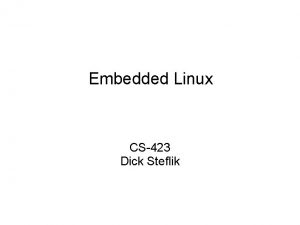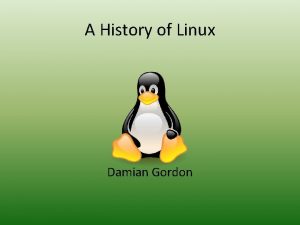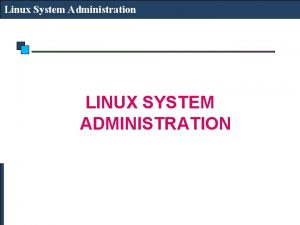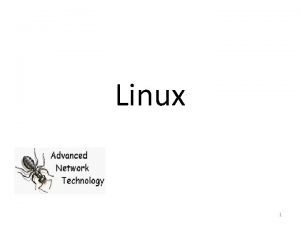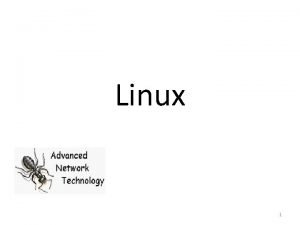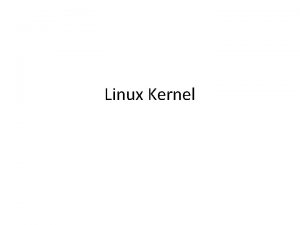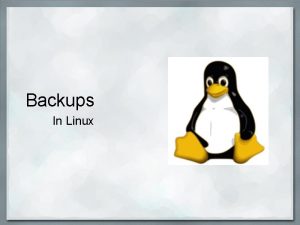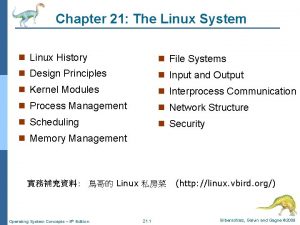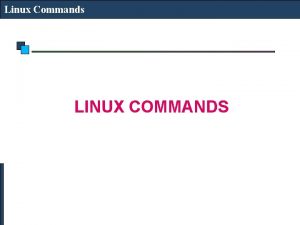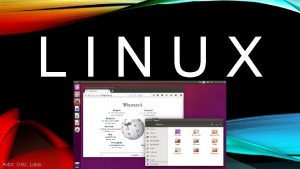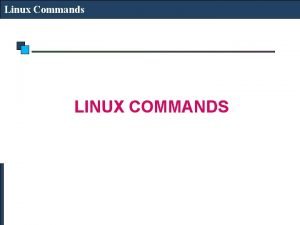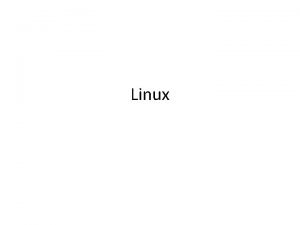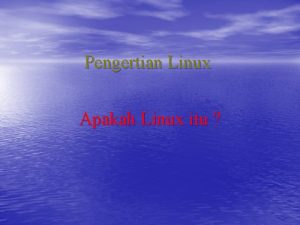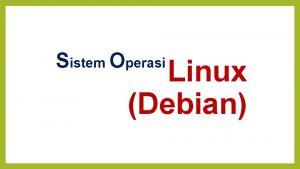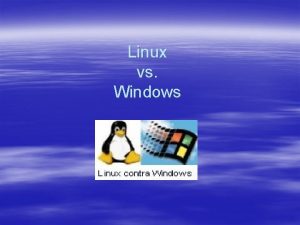Chapter 21 The Linux System n Linux History












































- Slides: 44

Chapter 21: The Linux System n Linux History (skip) n File Systems n Design Principles (skip) n Input and Output n Kernel Modules (skip) n Interprocess Communication n Process Management (skip) n Scheduling n Network Structure (skip) n Memory Management n Security (skip) 實務補充資料: 鳥哥的 Linux 私房菜 Operating System Concepts – 8 th Edition 21. 1 (http: //linux. vbird. org/) Silberschatz, Galvin and Gagne © 2009

Objectives n To explore the history of the UNIX operating system from which Linux is derived and the principles which Linux is designed upon (skip) n To examine the Linux process model and illustrate how Linux schedules processes n To look at memory management in Linux n To explore how Linux implements file systems and manages I/O devices n To illustrate how Linux provides interprocess communication (skip) Operating System Concepts – 8 th Edition 21. 2 Silberschatz, Galvin and Gagne © 2009

21. 4 Process Management n UNIX process management separates the creation of processes and the running of a new program into two distinct operations. l The fork() system call creates a new process l A new program is run after a call to exec() n Under UNIX, a process encompasses all the information that the operating system must maintain to track the context of a single execution of a single program n Under Linux, process properties fall into three groups: the process’s identity, environment, and context Operating System Concepts – 8 th Edition 21. 3 Silberschatz, Galvin and Gagne © 2009

Process Identity n Process ID (PID). The unique identifier for the process; used to specify processes to the operating system when an application makes a system call to signal, modify, or wait for another process n Credentials. Each process must have an associated user ID and one or more group IDs that determine the process’s rights to access system resources and files n Personality. Not traditionally found on UNIX systems, but under Linux each process has an associated personality identifier that can slightly modify the semantics of certain system calls l Used primarily by emulation libraries to request that system calls be compatible with certain specific flavors of UNIX Operating System Concepts – 8 th Edition 21. 4 Silberschatz, Galvin and Gagne © 2009

Process Environment n The process’s environment is inherited from its parent, and is composed of two null-terminated vectors: l The argument vector lists the command-line arguments used to invoke the running program; conventionally starts with the name of the program itself l The environment vector is a list of “NAME=VALUE” pairs that associates named environment variables with arbitrary textual values (like TERM and LANG) Operating System Concepts – 8 th Edition 21. 5 Silberschatz, Galvin and Gagne © 2009

Process Environment n Passing environment variables among processes and inheriting variables by a process’s children are flexible means of passing information to components of the user-mode system software l The environment-variable mechanism provides a customization of the operating system that can be set on a per-process basis, rather than being configured for the system as a whole Operating System Concepts – 8 th Edition 21. 6 Silberschatz, Galvin and Gagne © 2009

Process Context n Definition: The (constantly changing) state of a running program at any point in time n The scheduling context is the most important part of the process context; it is the information that the scheduler needs to suspend and restart the process n The kernel maintains accounting information about the resources currently being consumed by each process, and the total resources consumed by the process in its lifetime so far Operating System Concepts – 8 th Edition 21. 7 Silberschatz, Galvin and Gagne © 2009

Process Context (Cont) n The file table is an array of pointers to kernel file structures l When making file I/O system calls, processes refer to files by their index into this table n Whereas the file table lists the existing open files, the file-system context applies to requests to open new files l The current root and default directories to be used for new file searches are stored here n The signal-handler table defines the routine in the process’s address space to be called when specific signals arrive n The virtual-memory context of a process describes the full contents of the its private address space Operating System Concepts – 8 th Edition 21. 8 Silberschatz, Galvin and Gagne © 2009

Processes and Threads n Linux uses the same internal representation for processes and threads; a thread is simply a new process that happens to share the same address space as its parent n A distinction is only made when a new thread is created by the clone() system call l fork() creates a new process with its own entirely new process context l clone() creates a new process with its own identity, but that is allowed to share the data structures of its parent by passing a set of flags (CLONE_FS, CLONE_VM, CLONE_SIGHAND, CLONE_FILES) n Using clone gives an application fine-grained control over exactly what is shared between two threads Operating System Concepts – 8 th Edition 21. 9 Silberschatz, Galvin and Gagne © 2009

21. 5 Scheduling n The job of allocating CPU time to different tasks within an operating system – quota (配額) n While scheduling is normally thought of as the running and interrupting of processes, in Linux, scheduling also includes the running of the various kernel tasks n Running kernel tasks encompasses both tasks that are requested by a running process and tasks that execute internally on behalf of a device driver Operating System Concepts – 8 th Edition 21. 10 Silberschatz, Galvin and Gagne © 2009

Process Scheduling n Linux has two separate process-scheduling algorithms: l A time-sharing algorithm for fair, preemptive scheduling among multiple processes l An algorithm for real-time tasks where absolute priorities are more important than fairness n As of version 2. 5, a new scheduling algorithm runs in constant time. It is a preemptive, priority-based algorithm with two separate priority ranges, where lower values indicate higher priorities A real-time range from 0 to 99 l A nice value range from 100 to 140: based on the interactivity of the task, this value (up to 5) is added to or subtracted from a nice value l n It assigns higher priority tasks longer time quanta Operating System Concepts – 8 th Edition 21. 11 Silberschatz, Galvin and Gagne © 2009

Relationship Between Priorities and Time-slice Length Operating System Concepts – 8 th Edition 21. 12 Silberschatz, Galvin and Gagne © 2009

List of Tasks Indexed by Priority • The kernel maintains two priority arrays: active and expired. When all tasks in the active array have exhausted their time slice, the two priority arrays are exchanged. • Tasks are assigned dynamic priorities based on the nice value plus/minus a value up to 5, according to the interactivity of the task. This interactivity depends on how long it has been sleeping while waiting for I/O. Operating System Concepts – 8 th Edition 21. 13 Silberschatz, Galvin and Gagne © 2009

Linux Real-Time Scheduling n Implements the two classes required by POSIX. 1 b (Portable Operating System Interface for Unix) : l First time first served (FCFS) and Round-robin. In both cases, each process has a priority in addition to its scheduling class. l Always runs the process with he highest priority. 4 For processes with equal priority, it runs the one that has been waiting longest 4 FIFO processes continue to run until they either exit or block 4 A round-robin process will be preempted after a while and moved to the end of the scheduling queue, so that round-robin processes of equal priority automatically time-share between themselves n It is soft real-time: does not offer any guarantee about how quickly a real-time process will be scheduled once that the process becomes runnable Operating System Concepts – 8 th Edition 21. 14 Silberschatz, Galvin and Gagne © 2009

Kernel Synchronization n A request for kernel-mode execution can occur in two ways: l A running program may request an operating system service, either explicitly via a system call, or implicitly, for example, when a page fault occurs l A device driver may deliver a hardware interrupt that causes the CPU to start executing a kernel-defined handler for that interrupt n The problem is that all these tasks may try to access the same internal data structures. l Critical Sections: the portions of code that access these shared data n Kernel synchronization requires a framework that will allow the kernel’s critical sections to run without violating the integrity of the shared data Operating System Concepts – 8 th Edition 21. 15 Silberschatz, Galvin and Gagne © 2009

Kernel Synchronization n Linux (since 2. 6) kernel provides spinlocks and semaphores for locking in the kernel l On SMP (symmetric multiprocessing) machines, spinlock is the fundamental mechanism. The kernel is designed so that spinlock is held only for short durations. When a lock must be held for long, semaphores are used. l On single-CPU machines, the fundamental mechanism is enabling and disabling kernel preemption. (skip the paragraph below the table in p. 818) n The second protection technique applies to critical sections that occur in interrupt service routines l By using the processor’s interrupt control hardware to disable interrupts during a critical section, the kernel guarantees that it can proceed without the risk of concurrent access of shared data structures Operating System Concepts – 8 th Edition 21. 16 Silberschatz, Galvin and Gagne © 2009

Kernel Synchronization (Cont) n To avoid performance penalties, Linux’s kernel uses a synchronization architecture that allows long critical sections to run without having interrupts disabled for the critical section’s entire duration. It is useful for networking code. n Interrupt service routines are separated into a top half section and a bottom half section. l The top half is a normal interrupt service routine, and runs with recursive interrupts disabled. Bottom half interrupts will be queued. l The bottom half is run, with all interrupts enabled, by a miniature scheduler that ensures that bottom halves never interrupt themselves. Bottom half interrupts will again be queued. l This architecture is completed by a mechanism for disabling selected bottom halves while executing normal, foreground kernel code Operating System Concepts – 8 th Edition 21. 17 Silberschatz, Galvin and Gagne © 2009

Interrupt Protection Levels n Each level may be interrupted by code running at a higher level, but will never be interrupted by code running at the same or a lower level n User processes can always be preempted by another process when a time-sharing scheduling interrupt occurs Skip 21. 5. 3 Operating System Concepts – 8 th Edition 21. 18 Silberschatz, Galvin and Gagne © 2009

21. 6 Memory Management n Linux’s memory management has two components l The first deals with allocating and freeing physical memorypages, groups of pages, and small blocks of memory l The second handles virtual memory, which is memory mapped into the address space of running processes n We will describe these two components and then examine the mechanisms by which the loadable components of a new program are brought into a process’s virtual memory in response to an exec() system call Operating System Concepts – 8 th Edition 21. 19 Silberschatz, Galvin and Gagne © 2009

Management of Physical Memory n Linux splits physical memory into 3 different zones due to hardware characteristics For most routine memory requests For physical memory not mapped to kernel address space Relationship of Zones and Physical Addresses on 80 x 86 Operating System Concepts – 8 th Edition 21. 20 Silberschatz, Galvin and Gagne © 2009

Managing Physical Memory n The page allocator allocates and frees all physical pages; it can allocate ranges of physically-contiguous pages on request n The allocator uses a buddy system to keep track of available physical pages Each allocatable memory region is paired with an adjacent partner l Whenever two allocated partner regions are both freed up they are combined to form a larger region – a buddy heap l l If a small memory request cannot be satisfied by allocating an existing small free region, then a larger free region will be subdivided into two partners to satisfy the request Operating System Concepts – 8 th Edition 21. 21 Silberschatz, Galvin and Gagne © 2009

n Memory allocations in the Linux kernel occur either statically (drivers reserve a contiguous area of memory during system boot time) or dynamically (via the page allocator) • Most important memory-management subsystems are for virtual memory, the kmalloc() variable-length allocator, the slab allocator, and the page cache n The kernel maintains lists of pages in use by the kmalloc() service. Memory regions claimed by the kmalloc() system are allocated permanently until they are freed explicitly n Linux uses slab allocator for kernel memory (see next slide) Operating System Concepts – 8 th Edition 21. 22 Silberschatz, Galvin and Gagne © 2009

Slab Allocator in Linux A slab may be in one of three states: Full, Empty, Partial The page cache is the kernel’s main cache for block devices and memory-mapped files Operating System Concepts – 8 th Edition 21. 23 Silberschatz, Galvin and Gagne © 2009

Virtual Memory n The VM system maintains the address space visible to each process. l It creates pages of virtual memory on demand, and manages the loading of those pages from disk or their swapping back out to disk as required n The VM manager maintains two separate views of a process’s address space: l A logical view describing instructions concerning the layout of the address space 4 The address space consists of a set of nonoverlapping regions, each representing a continuous, page-aligned subset of the address space. Each region is described by a single vm_area_structure that defines the region’s properties. The regions for each address space are linked into a balanced binary tree. l A physical view of each address space which is stored in the hardware page tables for the process Operating System Concepts – 8 th Edition 21. 24 Skip 21. 6. 2. 1 Silberschatz, Galvin and Gagne © 2009

Lifetime of a Virtual Address Space n The kernel creates a new virtual address space in two cases: 1. When a process runs a new program with the exec system call 4 On executing a new program, the process is given a new, completely empty virtual-address space; the programloading routines populate the address space with virtualmemory regions Operating System Concepts – 8 th Edition 21. 25 Silberschatz, Galvin and Gagne © 2009

2. Upon creation of a new process by the fork system call. It involves creating a complete copy of the existing process’s virtual address space 4 The kernel copies the parent process’s vm_area_struct descriptors, then creates a new set of page tables for the child 4 The parent’s page tables are copied directly into the child’s, with the reference count of each page covered being incremented 4 After the fork, the parent and child share the same physical pages of memory in their address spaces 4 For virtual memory regions that are mapped privately, they are set to be read only and are marked for copy-on-write. Operating System Concepts – 8 th Edition 21. 26 Silberschatz, Galvin and Gagne © 2009

Swapping and Paging n The VM paging system relocates pages of memory from physical memory out to disk when the memory is needed for something else n The VM paging system can be divided into two sections: l The pageout-policy algorithm decides which pages to write out to disk, and when 4 A multiple-pass clock is used for a modified second-chance algorithm. An age valuing allows the pager to replace pages based on least frequently used (LFU) policy l The paging mechanism actually carries out the transfer, and pages data back into physical memory as needed 4 Supports paging both to dedicated swap devices and partitions and to normal files. Blocks are allocated from the swap devices according to a bitmap of used blocks. The allocator uses a next-fit algorithm to write to continuous disk blocks Operating System Concepts – 8 th Edition 21. 27 Silberschatz, Galvin and Gagne © 2009

Kernel Virtual Memory n The Linux kernel reserves a constant, architecture- dependent region of the virtual address space of every process for its own internal use n This kernel virtual-memory area contains two regions: l A static area that contains page table references to every available physical page of memory in the system, so that there is a simple translation from physical to virtual addresses when running kernel code Operating System Concepts – 8 th Edition 21. 28 Silberschatz, Galvin and Gagne © 2009

Kernel Virtual Memory l The reminder of the reserved section is not reserved for any specific purpose; its page-table entries can be modified to point to any other areas of memory. The kernel provides two facilities for processes to use this virtual memory 4 vmalloc(): allocates physically non-contiguous memory into a virtually contiguous kernel memory 4 vremap(): maps a sequence of virtual addresses for memorymapped I/O Skip 21. 6. 3 (p. 826 – p. 828) Operating System Concepts – 8 th Edition 21. 29 Silberschatz, Galvin and Gagne © 2009

21. 07 File Systems n To the user, Linux’s file system appears as a hierarchical directory tree obeying UNIX semantics n Internally, the kernel hides implementation details and manages the multiple different file systems via an abstraction layer, that is, the virtual file system (VFS) n The Linux VFS is designed around object-oriented principles and is composed of two components: l A set of definitions that define what a file-system object is allowed to look like 4 An inode-object represents an individual files; A file-object represents an open file; A superblock object represents an entire file system; A dentry object represents an individual directory entry 4 For each object type, the VFS defines a set of operations. Every object contains a pointer to a function table. l A layer of software to manipulate those objects Operating System Concepts – 8 th Edition 21. 30 Silberschatz, Galvin and Gagne © 2009

The Virtual File System n An inode object contains pointers to the disk blocks that contain the actual file contents. Directory operations are defined here. n A file object represents a point of access to the data in an open file. It belongs to a process. l It keeps track of reading/writing position of the file. It remembers whether the process asked for write permissions and tracks the process’s activity for adaptive read-ahead. n The kernel maintains a superblock object for each mounted disk device. The main responsibility of the superblock object is to provide access to inodes. n A dentry object represents a directory entry in the path name of a file. Operating System Concepts – 8 th Edition 21. 31 Silberschatz, Galvin and Gagne © 2009

The Linux ext 2 fs File System n ext 2 fs uses a mechanism similar to that of BSD Fast File System (ffs) for locating data blocks belonging to a specific file with upto three levels of indirecting n The main differences between ext 2 fs and ffs concern their disk allocation policies In ffs, the disk is allocated to files in blocks of 8 Kb, with blocks being subdivided into fragments of 1 Kb to store small files or partially filled blocks at the end of a file l ext 2 fs does not use fragments; it performs its allocations in smaller units l 4 The default block size on ext 2 fs is 1 Kb, although 2 Kb and 4 Kb blocks are also supported Operating System Concepts – 8 th Edition 21. 32 Silberschatz, Galvin and Gagne © 2009

The Linux ext 2 fs File System l ext 2 fs uses allocation policies designed to place logically adjacent blocks of a file into physically adjacent blocks on disk, so that it can submit an I/O request for several disk blocks as a single operation n The ext 2 fs allocation policy: l An ext 2 fs file is partitioned into multiple block groups 4 For data blocks, it attempts to allocate the file to the block group to which the file’s inode has been allocated 4 For inode allocations for nondirectory files, it selects the block group in which the file’s parent directory resides 4 Directory files are dispersed throughout the available block groups Operating System Concepts – 8 th Edition 21. 33 Silberschatz, Galvin and Gagne © 2009

The Linux ext 2 fs File System l Within a block group, ext 2 fs tries to keep allocations physically contiguous if possible, reducing the fragmentation if it can. 4 It maintains a bitmap of all free blocks in a block group 4 The search for free blocks in performed in two stages – First, ext 2 fs searches for an entire free byte in the bitmap; if it fails to find one, it looks for any free bit – Once a free block has been identified, the search is extended backward until an allocated block is encountered. Then ext 2 fs extends the allocation forward for up to eight blocks and preallocate these extra blocks to the file Operating System Concepts – 8 th Edition 21. 34 Silberschatz, Galvin and Gagne © 2009

Ext 2 fs Block-Allocation Policies Skip 21. 7. 3 Operating System Concepts – 8 th Edition 21. 35 Silberschatz, Galvin and Gagne © 2009

The Linux Process File System n VFS enables us to implement a file system that provides an interface to other functionality n The contents of proc file system are computed on demand according to user file I/O requests l SVR 4 UNIX introduced a /proc file system as an interface to the kernel’s process debugging support 4 Each l subdirectory corresponded to an active process Linux extends it by adding extra directories and text files under /proc 4 For various statistics about the kernel and the associated loaded drivers. Previously, the ps command was implemented as a privileged process to read directly from the kernel’s virtual memory. Now it is implemented as an unprivileged program 21. 7. 4 期末考不考 Operating System Concepts – 8 th Edition 21. 36 Silberschatz, Galvin and Gagne © 2009

The Linux Process File System n The /proc file system must implement two things: l a directory structure, and the file contents within n It must define a unique and persistent inode number for each directory and the associated files l It uses this inode number to identify just what operation is required when a user tries to read from a particular file inode or perform a lookup in a particular directory inode l When data is read from one of these files, the /proc file system collects the appropriate information, formats it into text form and places it into the requesting process’s read buffer Operating System Concepts – 8 th Edition 21. 37 Silberschatz, Galvin and Gagne © 2009

The Linux Process File System l The inode number is split into two fields: the top 16 bits are as a PID, and the remaining bits define what type of information is being requested about that process 4 A zoro PID field is for global information n It also maintains a tree data structure of registered global /proc file-system entries. Each entry contains the file’s inode number, file name, access permissions, and the specific functions to generate the file’s contents. Operating System Concepts – 8 th Edition 21. 38 Silberschatz, Galvin and Gagne © 2009

21. 8 Input and Output n To the user, all device drivers appear as normal files. l The system administrator can create special files within a file system that contain references to a specific device driver, and a user opening such a file will be able to read from and write to the device referenced. n Linux splits all devices into three classes: l block devices allow random access to completely independent, fixed size blocks of data l character devices include most other devices. They are accessed only sequentially l network devices are interfaced via the kernel’s networking subsystem. They must communicate indirectly by opening a connection to the kernel’s networking subsystem Operating System Concepts – 8 th Edition 21. 39 Silberschatz, Galvin and Gagne © 2009

Device-Driver Block Structure Operating System Concepts – 8 th Edition 21. 40 Silberschatz, Galvin and Gagne © 2009

Block Devices n Provide the main interface to all disk devices in a system n In block devices, a block represents the unit with which the kernel performs I/O. When a block is read into memory, it is stored in a buffer. The block buffer cache serves two main purposes: it acts as a pool of buffers for active I/O; and it serves as a cache for completed I/O n The request manager manages the reading and writing of buffer contents to and from a block device driver Operating System Concepts – 8 th Edition 21. 41 Silberschatz, Galvin and Gagne © 2009

Block Devices n A separate list of requests is kept for each block device driver l Traditionally, they are scheduled according to a C-SCAN algorithm l In version 2. 6, a deadline is associated with each request to address the starvation issue. The deadline scheduler maintains a sorted queue of pending I/O operations ordered by sector number. It also maintains a read queue for read operations and a write queue for write operations. These two queues are ordered according to deadline. Operating System Concepts – 8 th Edition 21. 42 Silberschatz, Galvin and Gagne © 2009

Character Devices n It can be any device driver which does not offer random access to fixed blocks of data l A character device driver must register a set of functions which implement the driver’s various file I/O operations l The kernel performs almost no preprocessing of a file read or write request to a character device, but simply passes on the request to the device n The main exception to this rule is the special subset of character device drivers which implement terminal devices, for which the kernel maintains a standard interface by a set of tty_structure. Each of these structures provides buffering and flow control Operating System Concepts – 8 th Edition 21. 43 Silberschatz, Galvin and Gagne © 2009

Character Devices n A line discipline is an interpreter for the information from the terminal device. The most common one is the tty discipline for a user’s running processes. n Other line disciplines are implemented that have nothing to do with I/O to a user process. The PPP and SLIP networking protocols encodes a networking connection over a terminal device such as a serial line. l These protocols are implemented as drivers that (1) appear to the terminal system as line disciplines; (2) appear to the networking system as network-device drivers. Operating System Concepts – 8 th Edition 21. 44 Silberschatz, Galvin and Gagne © 2009
 Linux kernel linux security module m1
Linux kernel linux security module m1 Cs423
Cs423 Linux timeline history
Linux timeline history Linux login history
Linux login history Linux kernel history
Linux kernel history Hình ảnh bộ gõ cơ thể búng tay
Hình ảnh bộ gõ cơ thể búng tay Frameset trong html5
Frameset trong html5 Bổ thể
Bổ thể Tỉ lệ cơ thể trẻ em
Tỉ lệ cơ thể trẻ em Voi kéo gỗ như thế nào
Voi kéo gỗ như thế nào Chụp tư thế worms-breton
Chụp tư thế worms-breton Hát lên người ơi alleluia
Hát lên người ơi alleluia Kể tên các môn thể thao
Kể tên các môn thể thao Thế nào là hệ số cao nhất
Thế nào là hệ số cao nhất Các châu lục và đại dương trên thế giới
Các châu lục và đại dương trên thế giới Công thức tính thế năng
Công thức tính thế năng Trời xanh đây là của chúng ta thể thơ
Trời xanh đây là của chúng ta thể thơ Cách giải mật thư tọa độ
Cách giải mật thư tọa độ Phép trừ bù
Phép trừ bù Phản ứng thế ankan
Phản ứng thế ankan Các châu lục và đại dương trên thế giới
Các châu lục và đại dương trên thế giới Thơ thất ngôn tứ tuyệt đường luật
Thơ thất ngôn tứ tuyệt đường luật Quá trình desamine hóa có thể tạo ra
Quá trình desamine hóa có thể tạo ra Một số thể thơ truyền thống
Một số thể thơ truyền thống Cái miệng xinh xinh thế chỉ nói điều hay thôi
Cái miệng xinh xinh thế chỉ nói điều hay thôi Vẽ hình chiếu vuông góc của vật thể sau
Vẽ hình chiếu vuông góc của vật thể sau Biện pháp chống mỏi cơ
Biện pháp chống mỏi cơ đặc điểm cơ thể của người tối cổ
đặc điểm cơ thể của người tối cổ Thứ tự các dấu thăng giáng ở hóa biểu
Thứ tự các dấu thăng giáng ở hóa biểu Vẽ hình chiếu đứng bằng cạnh của vật thể
Vẽ hình chiếu đứng bằng cạnh của vật thể Phối cảnh
Phối cảnh Thẻ vin
Thẻ vin đại từ thay thế
đại từ thay thế điện thế nghỉ
điện thế nghỉ Tư thế ngồi viết
Tư thế ngồi viết Diễn thế sinh thái là
Diễn thế sinh thái là Các loại đột biến cấu trúc nhiễm sắc thể
Các loại đột biến cấu trúc nhiễm sắc thể Thế nào là số nguyên tố
Thế nào là số nguyên tố Tư thế ngồi viết
Tư thế ngồi viết Lời thề hippocrates
Lời thề hippocrates Thiếu nhi thế giới liên hoan
Thiếu nhi thế giới liên hoan ưu thế lai là gì
ưu thế lai là gì Khi nào hổ mẹ dạy hổ con săn mồi
Khi nào hổ mẹ dạy hổ con săn mồi Khi nào hổ con có thể sống độc lập
Khi nào hổ con có thể sống độc lập Sơ đồ cơ thể người
Sơ đồ cơ thể người

